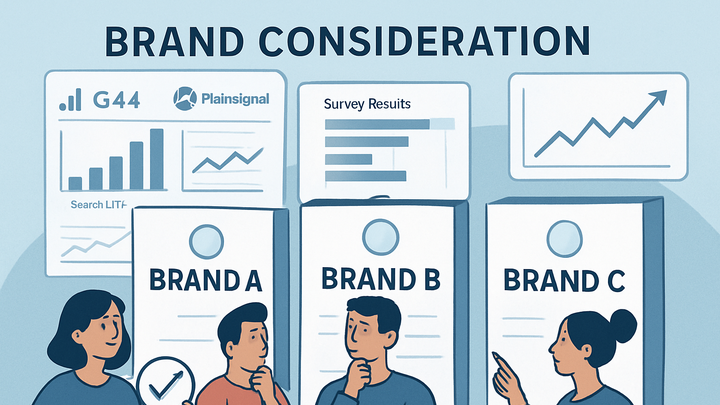Published on 2025-06-27T21:14:38Z
What is Brand Consideration? Examples for Brand Consideration
Brand Consideration refers to the likelihood that potential customers will evaluate and include your brand in their decision-making process. It sits between brand awareness and purchase intent in the marketing funnel. High brand consideration indicates that consumers are seriously considering your products or services, which often translates to higher conversion rates and customer loyalty. Marketers track brand consideration using a combination of surveys (e.g., ad recall or preference polls), behavioral metrics (e.g., repeat visits, time on page, video completions), and search lift analysis. Analytics platforms like GA4 and privacy-first tools such as PlainSignal (cookie-free simple analytics) enable you to set up custom events, track engagement, and measure search-driven traffic to quantify consideration. By analyzing these signals, you can optimize campaigns, messaging, and targeting to move prospects closer to purchase.
Brand consideration
Measure of how likely consumers are to consider a brand before purchase, tracked through surveys, behavioral metrics, and analytics tools.
Why Brand Consideration Matters
Understanding brand consideration is vital because it directly influences purchase decisions and long-term loyalty.
-
Decision stage influence
Signals how your brand shapes consumer choices at the moment of decision.
-
Revenue impact
Higher consideration typically leads to increased sales and better ROI.
Measuring Brand Consideration in Analytics
Brand consideration can be quantified using qualitative and quantitative approaches.
-
Surveys and polls
Collect direct feedback on consumer preferences through on-site or third-party surveys.
-
Ad recall surveys
Measure how well consumers remember your ads.
-
-
Behavioral metrics
Analyze on-site behavior like repeat visits, time on page, and video completions.
-
Session duration
Longer sessions often indicate deeper brand interest.
-
-
Search lift analysis
Track changes in branded search volume after marketing activities.
-
Google trends integration
Compare search interest trends over time.
-
Implementing Brand Consideration Tracking
To track brand consideration, set up custom events and monitor key metrics in your analytics stack.
-
Define custom events
Create events like
brand_consideration_vieworbrand_video_engagement.-
GA4 configuration
Use the GA4 Events interface or gtag.js to define events.
-
-
Configure brand search monitoring
Set up alerts for spikes in branded search terms.
-
Search console linking
Integrate Google Search Console with GA4 for query insights.
-
Examples: Using GA4 and PlainSignal
Here’s how to implement brand consideration tracking with GA4 and PlainSignal.
-
GA4 implementation
Use the gtag.js snippet to send custom brand consideration events.
-
Example
gtag('event', 'brand_consideration', { 'value': 1 });
-
-
PlainSignal setup
Embed the PlainSignal script to capture behavior without cookies.
-
Tracking code
<link rel="preconnect" href="//eu.plainsignal.com/" crossorigin /> <script defer data-do="yourwebsitedomain.com" data-id="0GQV1xmtzQQ" data-api="//eu.plainsignal.com" src="//cdn.plainsignal.com/plainsignal-min.js"></script>
-
Best Practices and Common Pitfalls
Ensure accurate insights by following best practices and avoiding common mistakes.
-
Ensure data privacy compliance
Obtain user consent and respect regulations like GDPR when tracking behavior.
-
Avoid over-reliance on a single metric
Combine multiple signals (survey + behavior + search) for a complete view.
